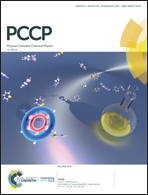Hybrid patterns from directed self-assembly of diblock copolymers by chemical patterns
Abstract
The surface affinity is a critical factor for controlling the formation of monolayer nanostructures in block copolymer thin films. In general, strong surface affinity tends to induce the formation of domains with low spontaneous curvature. Abiding by this principle, we propose a facile chemoepitaxial scheme for producing large-scale ordered hybrid patterns by the directed self-assembly of diblock copolymers. The guiding chemical pattern is designed as periodic stripes with alternately changing surface affinities. As a consequence, two different geometries of domains are formed on the stripes with different affinities. The self-assembly process of block copolymers guided by the stripe patterns is investigated using cell dynamics simulations based on time-dependent Ginzburg–Landau theory, and the kinetic stability diagram is estimated. Hybrid patterns are successfully achieved with both cylinder-forming and sphere-forming diblock copolymers. In the cylinder-forming system, the major hybrid pattern exhibiting a considerable stability window is composed of parallel cylinders and perforated lamellae, while it is composed of monolayer spheres and parallel cylinders in the other system. Encouragingly, the chemoepitaxial method is valid till the period of the guiding pattern is a large multiple of the domain spacing. The chemoepitaxial scheme demonstrated in this work serves as a nice supplement to the graphoepitaxial one proposed in our previous work.

- This article is part of the themed collection: 2019 PCCP HOT Articles


 Please wait while we load your content...
Please wait while we load your content...